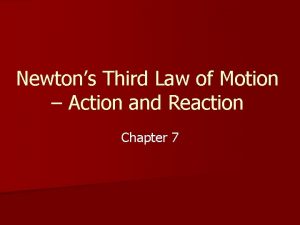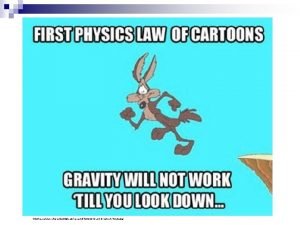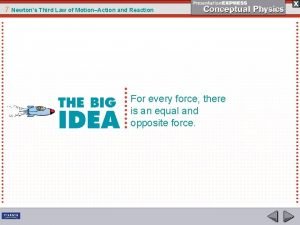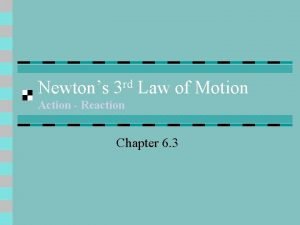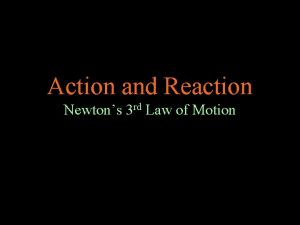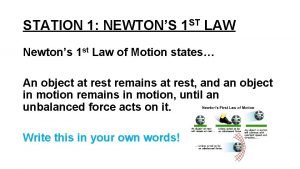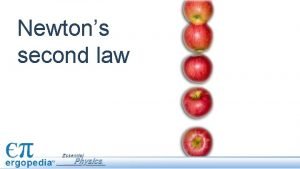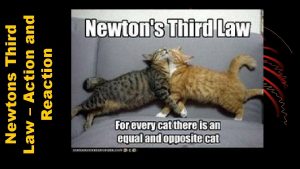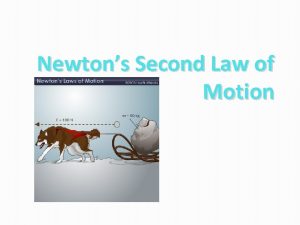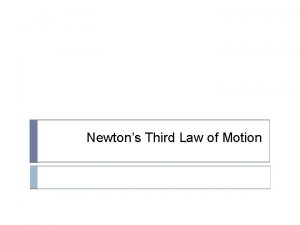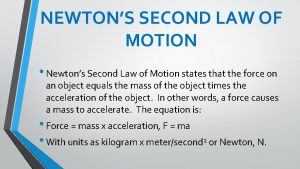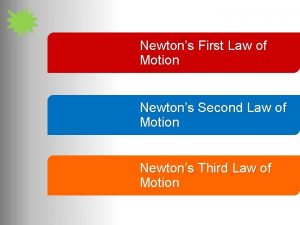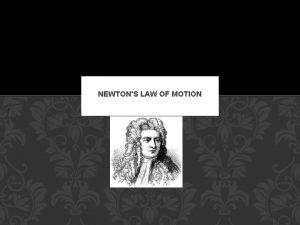Newtons 3 rd Law of Motion Action Reaction













- Slides: 13

Newton’s 3 rd Law of Motion Action - Reaction Chapter 6. 3

Newton’s 2 nd Law (a = F/m) • Newton’s second law is responsible for explaining how objects increase or decrease in speed, or change direction. • • If the force is increased, the object will accelerate. If the mass is increased, the object will accelerate more slowly. When an object changes direction, it is also said to be accelerating. Huh? You will see… Newton’s 2 nd Law can also be used to explain the forces that exist on stationary objects like your weight or the repulsive and attractive forces of two magnets.

What is the source of a force? • If you pull on a rope, do you feel the rope pull on you? • Which is the source of the force, you or the rope?

Interaction Pairs • All forces exist in pairs (no isolated forces) that are opposite in direction and equal in magnitude (size). • • When you kick a ball, you exert a force on the ball while the ball exerts a force on you. You pull on a door to open it while the door exerts a force on you. A hammer exerts a force on a nail while the nail exerts a force on the hammer. When you pull on a rope, it pulls on you.

Newton’s 3 rd Law of Motion • When one object exerts a force on another object, the second object exerts an equal but oppositely directed force on the first object. • For every action there is an equal but opposite reaction. (Newton’s 3 rd Law is sometimes referred to as the “law of action - reaction. ”)

Free Body Diagram of Newton’s 3 rd Law of Motion Fg(book on Earth) = Fg(Earth on book) Fg = Force of gravity (Book on Earth) “Reaction” Fg = Force of gravity (Earth on Book “Action” Note that the forces come in pairs that have symmetry.

Action - Reaction Fg (car on Earth) FN (road on car) Ff (road on car) Fg (Earth on car) Ff (car on road) Reaction Action Fg (Earth on car) FN (road on car) Ff (road on car) ---- = = = Fg (car on Earth) FN (car on road) Ff (car on road) Note: All forces come in equal and opposite pairs FN (car on road)

What is the Reaction Force? • You push on your desk. • • An airplane propeller pushes on the air. • • The air pushes on the airplane propeller. A tennis racquet hits a ball. • • The desk pushes on you. A ball hits a tennis racquet. You push on the floor as you take a step. • The floor pushes back on you.

Do the forces cancel each other out? • No. • Since the forces act on different objects, it is not possible for them to cancel each other out. Ff = mfaf Force of floor on person. Fp = m p a p Force of person on floor.

rd 3 Newton’s Law of Motion & Acceleration • Newton’s 3 rd Law of Motion says that F 1 = F 2 • And Newton’s 2 nd Law of Motion says that m 1 a 1 = m 2 a 2 • While the forces may be equal but opposite in direction, the accelerations of each object may be different. F 1 F 2

Example: Newton’s Motion rd 3 Law of A physics student is pulling on a rope, which in both cases causes the scale to read 500 Newtons. The physics student is pulling a. with more force when the rope is attached to the wall. b. with more force when the rope is attached to the elephant. c. the same force in each case.

Newton’s 3 rd Law of Motion? • Does the following diagram illustrate an action-reaction pair? • No, because both forces act on the same object. FN = Normal force of Desk on Book FN = Fg Fg = Force of Gravity on Book

Key Ideas • • Newton’s 3 rd Law of Motion states that when two objects interact, the magnitude of the force exerted by object 1 on object 2 is equal to the magnitude of the force simultaneously exerted by object 2 on object 1, and are in opposite directions. Newton’s 3 rd Law of Motion is also known as the Law of Action-Reaction. All forces in nature come in pairs. While the forces are equal and opposite, they do not cancel each other out because the two forces act on two different objects.
 According to the third law of motion action and reaction
According to the third law of motion action and reaction According to the third law of motion, action and reaction
According to the third law of motion, action and reaction Newtons 3 rd law of motion
Newtons 3 rd law of motion Newtons 3 rd law of motion
Newtons 3 rd law of motion Newton’s 3rd law
Newton’s 3rd law Rd law
Rd law Newton's second law meme
Newton's second law meme Newtons third law of motion
Newtons third law of motion Newton's 3 laws of motion
Newton's 3 laws of motion Newtons 3 rd law of motion
Newtons 3 rd law of motion Newton's third law rockets
Newton's third law rockets Newtons 3 rd law of motion
Newtons 3 rd law of motion Newtons 1st law.
Newtons 1st law. Second law of newton
Second law of newton
